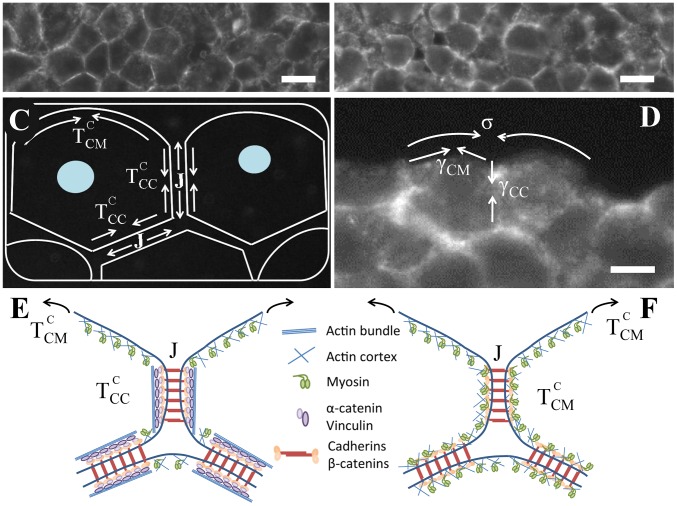Figure 1. F9 versus F9 .
.
Cross sections of a F9 WT aggregate (A) and of a F9 aggregate (B). The staining is for
aggregate (B). The staining is for  -catenin, scale bars, 10
-catenin, scale bars, 10  . (C) Schematic representation of the cortical contractions at the cell-extracellular medium interface (
. (C) Schematic representation of the cortical contractions at the cell-extracellular medium interface ( ), at the cell-cell interface (
), at the cell-cell interface ( ) and of the adhesion energy J.
) and of the adhesion energy J.  and
and  increase the tissue surface tension, whereas
increase the tissue surface tension, whereas  decreases it (see Eq. 2). (D) Closer view of two F9
decreases it (see Eq. 2). (D) Closer view of two F9 cells in contact. The difference between the interfacial tensions at the cell-cell
cells in contact. The difference between the interfacial tensions at the cell-cell  and cell-extracellular medium
and cell-extracellular medium  interfaces gives the aggregate surface tension (
interfaces gives the aggregate surface tension ( ).
).  increases the surface tension whereas
increases the surface tension whereas  decreases it. Scale bar, 5
decreases it. Scale bar, 5  . (E-F) Cartoons of cell-cell contacts in the case of F9 WT cells (E) and F9
. (E-F) Cartoons of cell-cell contacts in the case of F9 WT cells (E) and F9 cells (F). The presence of
cells (F). The presence of  -catenin at cell-cell junction is described as a catalyzer for actin reorganization at cell-cell junctions.
-catenin at cell-cell junction is described as a catalyzer for actin reorganization at cell-cell junctions.

